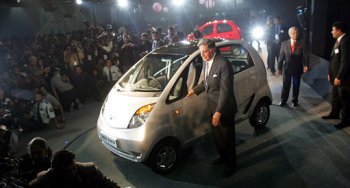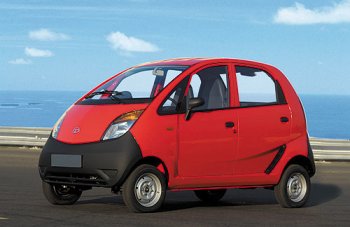 |
Speaking at the unveiling ceremony at the
9th Auto Expo in New Delhi (above), Mr.
Ratan N. Tata said, “I observed families
riding on two-wheelers – the father driving
the scooter, his young kid standing in front
of him, his wife seated behind him holding a
little baby. It led me to wonder whether one
could conceive of a safe, affordable,
all-weather form of transport for such a
family." Photo: New York Times. |
|
|

 |
The People’s Car, designed with a family in
mind, has a roomy passenger compartment with
generous leg space and head room. It can
comfortably seat four persons. Four doors
with high seating position make ingress and
egress easy. |
|
|
|
Tata Motors
Chairman Ratan Tata has hinted at Fiat's involvement in
the just unveiled low cost Tata Nano project and
suggested it could eventually go on sale in Europe with
Fiat's help. The Nano, which will cost 100,000 rupees
(US$2,500) when it goes on sale later this year made
headlines around the world when it was unveiled at the
9th New Delhi Auto Expo at the end of last week.
Ratan Tata's new
comments come in an interview with Italian magazine
Automobilismo which has been quoted by Reuters.
Asked about the possibility of bring the low-cost Nano,
designed for developing countries, to European markets he
said: "I don't exclude anything. It is an option that we are
still considering but I don't think it's impossible."
The magazine
also asked him about the possibility of including the Nano
project in the rapidly expanding joint venture with Fiat;
Tata admitted that this scenario was up for discussion,
saying: "I will talk about it with [Sergio] Marchionne."
The Tata Nano,
dubbed the 'People's Car' is set to be an important new
development, which signifies a first for the global
automobile industry, the People’s Car brings the comfort and
safety of a car within the reach of thousands of families.
The People’s Car will be launched in India later in 2008.
Speaking at the unveiling ceremony at the 9th Auto Expo in
New Delhi, Mr. Ratan N. Tata said, “I observed families
riding on two-wheelers – the father driving the scooter, his
young kid standing in front of him, his wife seated behind
him holding a little baby. It led me to wonder whether one
could conceive of a safe, affordable, all-weather form of
transport for such a family. Tata Motors’ engineers and
designers gave their all for about four years to realise
this goal. Today, we indeed have a People’s Car, which is
affordable and yet built to meet safety requirements and
emission norms, to be fuel efficient and low on emissions.
We are happy to present the People’s Car to India and we
hope it brings the joy, pride and utility of owning a car to
many families who need personal mobility.”
The People’s Car, designed with a family in mind, has a
roomy passenger compartment with generous leg space and head
room. It can comfortably seat four persons. Four doors with
high seating position make ingress and egress easy. Yet with
a length of 3.1 metres, width of 1.5 metres and height of
1.6 metres, with adequate ground clearance, it can
effortlessly manoeuvre on busy roads in cities as well as in
rural areas. Its mono-volume design, with wheels at the
corners and the powertrain at the rear, enables it to
uniquely combine both space and manoeuvrability, which will
set a new benchmark among small cars. When launched, the car
will be available in both standard and deluxe versions. Both
versions will offer a wide range of body colours, and other
accessories so that the car can be customised to an
individual’s preferences.
It features a rear-wheel drive, and an all-aluminium,
two-cylinder, 623 cc, 33 PS, multi point fuel injection
petrol engine. This is the first time that a two-cylinder
gasoline engine is being used in a car with single balancer
shaft. The lean design strategy has helped minimise weight,
which helps maximise performance per unit of energy consumed
and delivers high fuel efficiency. Performance is controlled
by a specially designed electronic engine management system.
The People’s Car’s safety performance exceeds current
regulatory requirements. With an all sheet-metal body, it
has a strong passenger compartment, with safety features
such as crumple zones, intrusion-resistant doors, seat
belts, strong seats and anchorages, and the rear tailgate
glass bonded to the body. Tubeless tyres further enhance
safety.
Its tailpipe emission performance exceeds regulatory
requirements. In terms of overall pollutants, it has a lower
pollution level than two-wheelers being manufactured in
India today. The high fuel efficiency also ensures that the
car has low carbon dioxide emissions, thereby providing the
twin benefits of an affordable transportation solution with
a low carbon footprint.
Tata Motors is India's largest automobile company, with
revenues of US $ 7.2 billion in 2006-2007. With over 4
million Tata vehicles plying in India, it is the leader in
commercial vehicles and the second largest in passenger
vehicles. It is also the world's fifth largest medium and
heavy truck manufacturer and the second largest heavy bus
manufacturer. Tata cars, buses and trucks are being marketed
in several countries in Europe, Africa, the Middle East,
South Asia, South East Asia and South America. Tata Motors
and Fiat Auto have formed an industrial joint venture in
India to manufacture passenger cars, engines and
transmissions for the Indian and overseas markets; Tata
Motors also has an agreement with Fiat Auto to build a
pick-up vehicle at Córdoba, Argentina. The company already
distributes Fiat branded cars in India. Tata Motors’
international footprint includes Tata Daewoo Commercial
Vehicle Co. Ltd. in South Korea; Hispano Carrocera, a bus
and coach manufacturer of Spain in which the company has a
21% stake; a joint venture with Marcopolo, the Brazil-based
body-builder of buses and coaches; and a joint venture with
Thonburi Automotive Assembly Plant Company of Thailand to
manufacture and market pick-up vehicles in Thailand. Tata
Motors has research centres in India, the U.K., and in its
subsidiary and associate companies in South Korea and Spain.
|